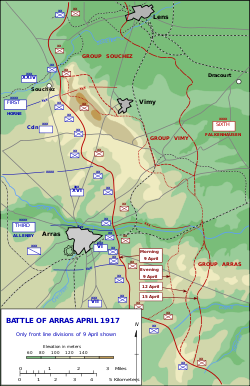
Back معركة أراس (1917) Arabic Бітва пры Арасе (1917) Byelorussian Schlacht bei Arras (1917) German Batalla de Arrás (1917) Spanish Arrasko gudua (1917) Basque Arrasin taistelu (1917) Finnish Bataille d'Arras (1917) French Batalla de Arras Galician קרב אראס (1917) HE Bitka kod Arrasa (1917.) Croatian
| Battle of Arras | |||||||
|---|---|---|---|---|---|---|---|
| Part of the Western Front of the First World War | |||||||
 The Battle of Arras, April 1917[image reference needed] | |||||||
| |||||||
| Belligerents | |||||||
|
| |||||||
| Commanders and leaders | |||||||
|
|
| ||||||
| Strength | |||||||
|
first day: 14 divisions 9 divisions in reserve |
first day: 12 divisions 5 divisions in reserve | ||||||
| Casualties and losses | |||||||
| 158,000 | 120,000–130,000 | ||||||
The Battle of Arras (also known as the Second Battle of Arras) was a British offensive on the Western Front during the First World War. From 9 April to 16 May 1917, British troops attacked German defences near the French city of Arras on the Western Front. The British achieved the longest advance since trench warfare had begun, surpassing the record set by the French Sixth Army on 1 July 1916. The British advance slowed in the next few days and the German defence recovered. The battle became a costly stalemate for both sides and by the end of the battle, the British Third Army and the First Army had suffered about 160,000 casualties and the German 6th Army about 125,000.
For much of the war, the opposing armies on the Western Front were at stalemate, with a continuous line of trenches from the Belgian coast to the Swiss border.[1] The Allied objective from early 1915 was to break through the German defences into the open ground beyond and engage the numerically inferior German Army (Westheer) in a war of movement. The British attack at Arras was part of the Anglo-French Nivelle Offensive, the main part of which was the Second Battle of the Aisne 50 mi (80 km) to the south.[2] The aim of the French offensive was to break through the German defences in forty-eight hours.[3] At Arras the Canadians were to capture Vimy Ridge, dominating the Douai Plain to the east, advance towards Cambrai and divert German reserves from the French front.[4]
The British effort was an assault on a relatively broad front between Vimy in the north-west and Bullecourt to the south-east. After a long preparatory bombardment, the Canadian Corps of the First Army in the north fought the Battle of Vimy Ridge, capturing the ridge. The Third Army in the centre advanced astride the Scarpe River and in the south, the Fifth Army attacked the Hindenburg Line (Siegfriedstellung) but made few gains. The British armies then conducted smaller attacks to consolidate the new positions. Although these battles were generally successful in achieving limited aims, they came at considerable cost.[4]
When the battle officially ended on 16 May, the British had made significant advances but had been unable to achieve a breakthrough.[4] New tactics and the equipment to exploit them had been used, showing that the British had absorbed the lessons of the Battle of the Somme and could mount set-piece attacks against field fortifications. After the Second Battle of Bullecourt (3–17 May), the Arras sector became a quiet front, typical of most of the war in the west, except for attacks on the Hindenburg Line and around Lens, culminating in the Canadian Battle of Hill 70 (15–25 August).
- ^ Ashworth 2000, pp. 3–4.
- ^ Ashworth 2000, pp. 48–51, 55–56.
- ^ Keegan 1999, pp. 348–352.
- ^ a b c Ashworth 2000, pp. 55–56.
© MMXXIII Rich X Search. We shall prevail. All rights reserved. Rich X Search